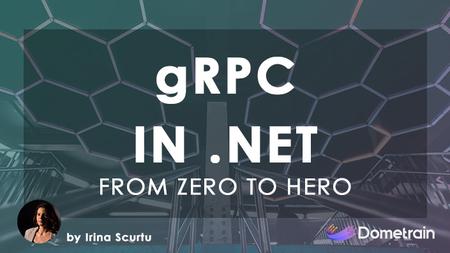English | MP4 | AVC 1920×1080 | AAC 44KHz 2ch | 71 Lessons (3h 24m) | 668 MB
Learn how to build gRPC applications in .NET using C#
gRPC (gRPC Remote Procedure Calls) is a high-performance remote procedure call framework initially created by Google. Since its public release, it has become one of the three most popular approaches to building APIs, not just in .NET but in any programming language (the other two being REST and GraphQL). Its use of Protocol Buffers, Bi-directional streaming, and integrated auth has made it one of the most performance and most popular frameworks, especially regarding internal service communication. It is used by companies like Google, Netflix, Square and Cisco, to name a few, and it is also part of the Cloud Native Computing Foundation. .NET has incredible first-party support for gRPC, and every .NET engineer should know how to utilize it to build scalable, clean and performance applications with gRPC. In this course, Irina Scurtu will take you from the very basics of gRPC to some advanced concepts on how to build and run gRPC applications.
Table of Contents
1 Welcome
2 What will you learn in this course
3 Who is this course for and prerequisites
4 What is gRPC
5 Where gRPC fits in the API ecosystem
6 gRPC vs WCF
7 gRPC vs RESTful APIs
8 When to use gRPC
9 Introduction to Protocol Buffers
10 What is a .proto file
11 Syntax
12 Scalar types
13 Enums
14 Well-known types
15 Nullable types
16 Any
17 OneOf
18 Language constructs
19 Creating your first gRPC project
20 Analyzing the project structure
21 Running the default template project
22 Code generation
23 gRPC types
24 Defining a gRPC service
25 Implementing a gRPC service
26 Unary Type
27 Client Streaming Type
28 Server Streaming Type
29 Bi-Directional Streaming Type
30 Creating & configuring a gRPC client project
31 What is a Channel and how can we use it
32 Creating a channel
33 Configuring a channel
34 Creating a client
35 Consuming a Unary Type method
36 Consuming a Client Streaming method
37 Consuming a Server Streaming method
38 Consuming a Bi-Directional Streaming method
39 Setting call deadlines
40 Sending cancelation requests
41 Consuming gRPC from an MVC app
42 HTTP Request and Response in the context of gRPC
43 Metadata
44 Trailers
45 gRPC status codes
46 Treating and working with Exceptions
47 Introducing interceptors
48 Client interceptors
49 Implementing client interceptors
50 Server interceptors
51 Implementing server interceptors
52 Middlewares vs Interceptors
53 Enabling compression
54 Avoiding compression
55 Client side load balancing
56 Choosing another policy
57 Transient fault handling in gRPC
58 Implementing a retry policy
59 Implementing a hedging policy
60 Writing unit tests
61 Writing integration tests
62 Using Postman
63 Security levels
64 Adding authentication and authorization to the server
65 Provide call credentials in the client application
66 Health checks
67 Discovering services with Reflection
68 Implementing transcoding
69 grpc-web
70 Code-first gRPC
71 Conclusion
Resolve the captcha to access the links!
